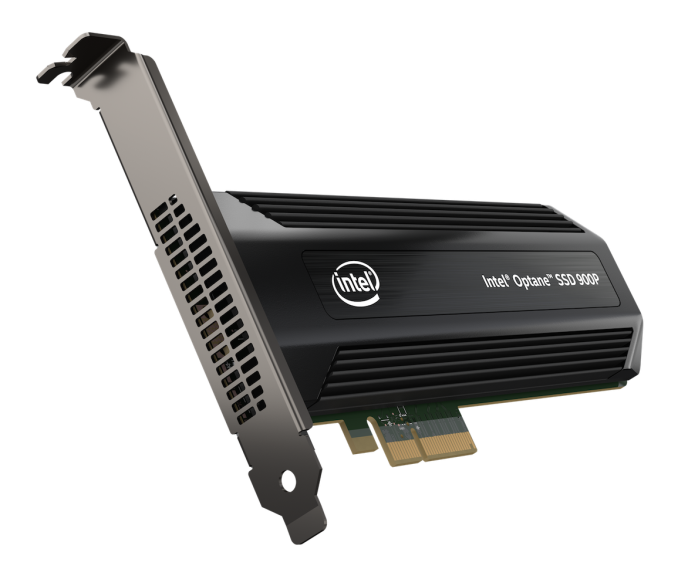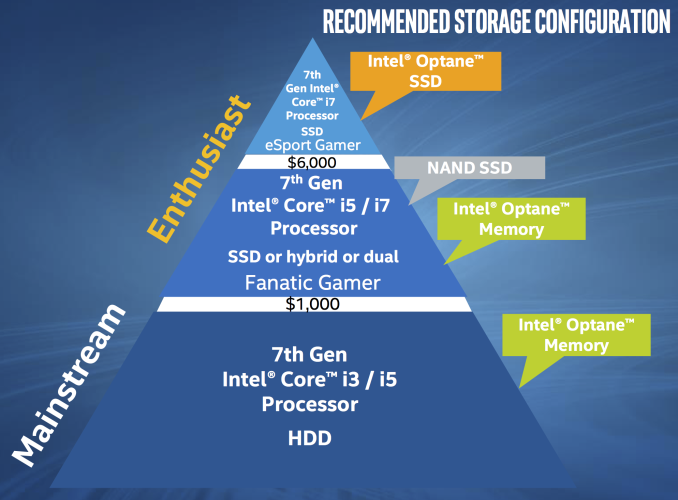The Intel Optane SSD 900P 280GB Review
by Billy Tallis on October 27, 2017 9:30 AM EST
Whenever Intel develops a new generation of SSDs based entirely on in-house technology, the result is usually a product that turns heads. Several times, Intel has set a new standard for SSD performance, starting with its original X25-M. Their most recent shake-up of the consumer SSD market was the Intel SSD 750, the first consumer NVMe SSD. Such significant releases don't happen every year, and in the intervening years Intel's competitors always catch up and surpass Intel.
However this year's revolution from Intel will be very hard for the competition to match anytime soon. All of Intel's previous record-setting SSDs have relied on the drive's controller to stand out from the crowd. This time, Intel's advantage comes from the storage medium: its 3D XPoint memory technology, a new nonvolatile memory that offers much higher performance than flash memory.
The Intel Optane SSD 900P
The new Intel Optane SSD 900P is a premium NVMe PCIe SSD offering the highest level of performance, with a moderate capacity. The Optane SSD 900P is intended for high-end desktop systems and workstations with very disk-heavy workloads. The Optane SSD 900P isn't for everyone and won't be displacing any existing products - it exists alone in a new product tier, with prices that are more than twice what the fastest flash memory based SSDs are selling for.
Optane is Intel's brand name for products featuring 3D XPoint memory. The Intel Optane SSD 900P is actually the third Optane product to be released, but it's the first family member to go after the high end consumer market segment. The Intel Optane Memory M.2 drives released earlier this year have capacities far too small for general-purpose storage use and instead have been marketed for use as a cache device to be paired with a mechanical hard drive. Intel's caching strategy works and can bring a hard drive's responsiveness up to the level of mainstream SSDs, but it has downsides. The Optane Memory caching requires a few extra steps to setup, and the caching software will only run on Intel platforms introduced this year: Kaby Lake or newer.
The Optane SSD DC P4800X is Intel's flagship enterprise SSD, and it is priced accordingly—putting it far out of reach of consumer budgets, and even with a price tag of over $1500 for 375GB it has been quite difficult to acquire. In the enterprise storage market, the P4800X has been highly sought after, but it isn't appropriate for all use cases and is not a threat to the many enterprise SSDs that prioritize capacity over performance and endurance.
The Optane SSD 900P will still cause some sticker shock for consumers expecting prices in line with M.2 PCIe SSDs, but it is acceptable for the kinds of machines that might be packing multiple GPUs or 10+ CPU cores. The Optane SSD 900P probably wouldn't be the only drive in such a system, but it would work well as a blazing fast primary storage device.
| Intel Optane SSD 900P Specifications | ||
| Capacity | 280 GB | 480 GB |
| Controller | Intel SLL3D | |
| Memory | Intel 128Gb 3D XPoint | |
| Interface | PCIe 3.0 x4 | |
| Form Factor | HHHL Add-in card or 2.5" 15mm U.2 |
HHHL Add-in card |
| Sequential Read | 2500 MB/s | |
| Sequential Write | 2000 MB/s | |
| Random Read IOPS | 550k | |
| Random Write IOPS | 500k | |
| Power Consumption | 8W Read 13W Write 14W Burst 5W Idle |
|
| Write Endurance | 10 DWPD | |
| Warranty | 5 years | |
| Recommended Price | $389 ($1.39/GB) | $599 ($1.25/GB) |
The Intel Optane SSD 900P is initially launching with 280GB and 480GB capacities. Both sizes will be available as PCIe 3.0 x4 half-height half-length add-in cards, and the 280GB model is also available as a 2.5" U.2 drive. Higher capacities may be added later, but Intel isn't promising anything yet. The sequential transfer speeds are nothing special for a NVMe SSD these days—Samsung's 960 PRO can hit much higher read speeds and slightly higher write speeds. The random read and write IOPS are far higher than any consumer SSD has offered before.
Intel's specifications for power consumption show one big reason why the Optane SSD 900P is a desktop-only product. Laptops are not equipped to supply up to 14W to a SSD, and they usually aren't equipped to cool a drive that idles at 5W instead of 50mW. The level of performance offered by the Optane SSD 900P cannot currently fit within the power budget or space constraints of a M.2 card.
The five year warranty Intel offers is typical for a high-end SSD in today's market, but doesn't compare to the 10 year warranty that Samsung's flagship 850 PRO SATA SSD offers. On the other hand, the 10 drive writes per day write endurance rating is far higher than most consumer SSDs get; 0.3 DWPD is more typical.
The Intel Optane SSD 900P starts shipping worldwide today, and here is our review of the 280GB version.











205 Comments
View All Comments
melgross - Friday, October 27, 2017 - link
You’re not as objective as you proclaim. If you were, you’d be more in line with what the conslucion says, which is that for many things there isn’t much of an advantage, but for others there is, and most of the reas\OSs aren’t the fault of this, but rather, old concepts in storage.ddriver - Friday, October 27, 2017 - link
So in order to be objective, I will have to echo what AT - a heavily pro-intel biassed website says about it? Yep, that sounds legit :)It would seem you confuse objectivity for conformity.
r0gue6 - Friday, October 27, 2017 - link
I can tell you are extremely bias simply because you use ignorant words like "hypetane" unironically.ddriver - Friday, October 27, 2017 - link
Hypetane is perfectly suited. The product turned out to be 90% hype, and it also rhymes. What more could anyone possibly want?And calling things for what they are is the very essence of objectivity.
shabby - Friday, October 27, 2017 - link
It is 1000 times faster... at die level, pcie and drivers show it down. /intel pr proddriver - Friday, October 27, 2017 - link
Sure, if you say so. I mean it is obviously saturating and exceeding the PCIE bandwidth and crippled by the PCIE latency.Oh wait, it isn't. Maybe it is intel's controller then. Who knows. I mean aside from you ;)
lmcd - Friday, October 27, 2017 - link
Ironic, because you aren't the king of anything.voicequal - Saturday, October 28, 2017 - link
It's pretty clear Intel's performance claims were speaking of the cell level (NAND vs 3D Xpoint), not the system level (SSD, SYSmark, etc).Drumsticks - Friday, October 27, 2017 - link
Not that anybody will ever convince you that anything Intel can do is good, but here is a graph of how much endurance the 480GB Optane SSD has in terms of TBW compared to the other Pro SSDs.https://www.pcper.com/files/imagecache/article_max...
ddriver - Friday, October 27, 2017 - link
Cool, even if not real-world maxing out but intel's claim, I am willing to assume that intel won't lie on the spec sheet of an actual product.But then again, I am going to refer you to this little gem:
http://images.hardwarecanucks.com/image/akg/Storag...
The rated number is still almost 50 times less than what intel claimed officially. 45 times less is pretty significant IMO. Imagine getting a job where they promise you 20k $ a month, and end up paying you 450$ instead. Not cool. In light of that, I wouldn't say my criticism is ungrounded.
For me personally, 20 times better endurance than NAND is pretty good, good enough to justify the purchase even at the present price.
Now if only intel started out with a 20x claim instead of the 1000x claim, I wouldn't have any legit reason to bash that product. And maybe if more call intel on their BS, they just might cut it. And I don't think that will be a bad thing.